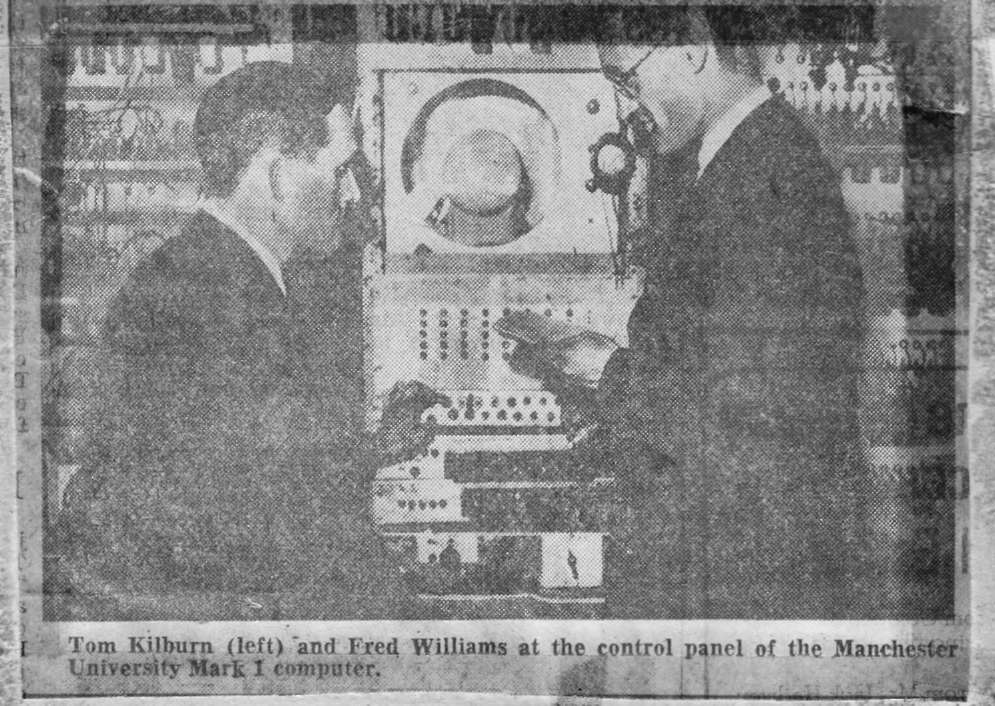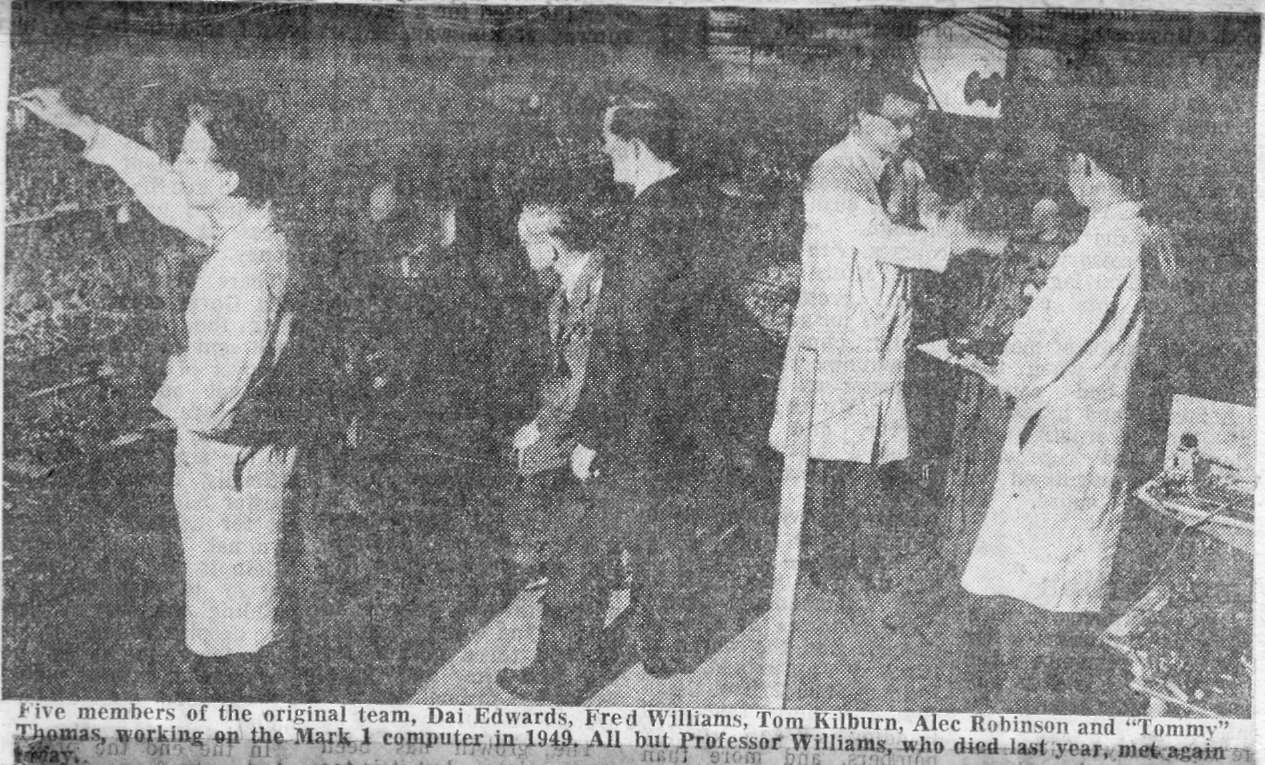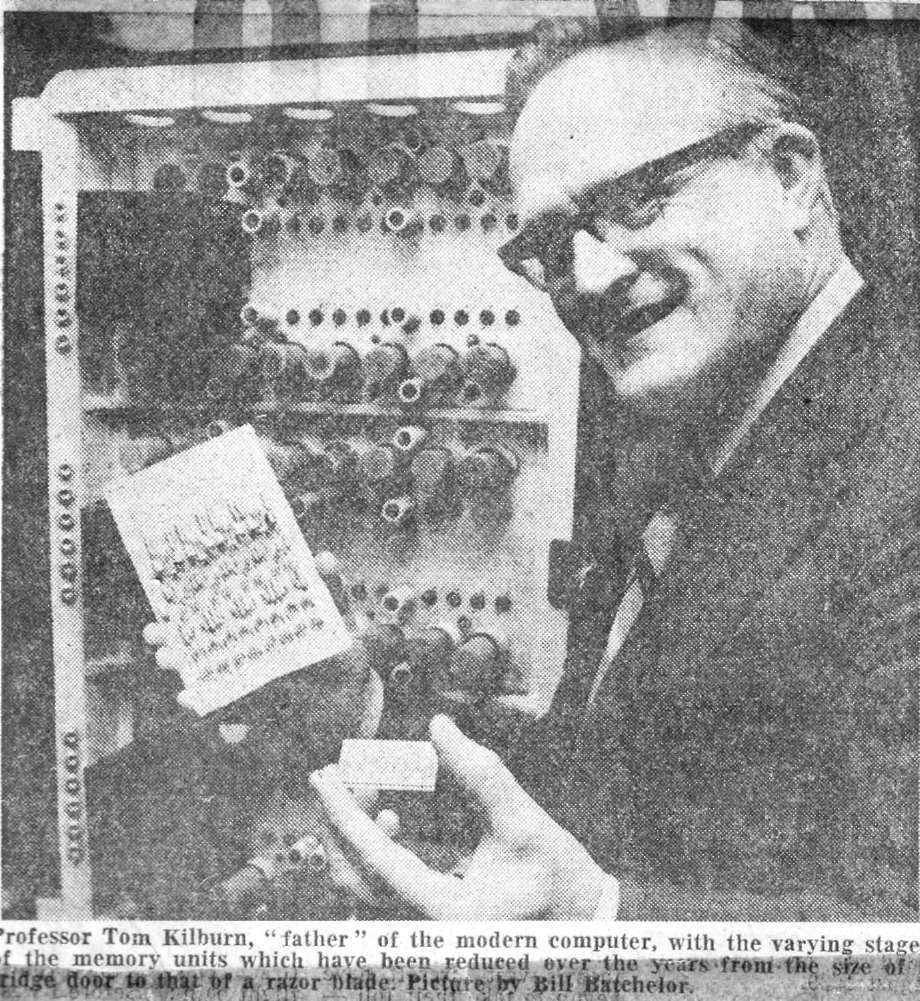
Manchester Evening News, Weds June 21st, 1978.
THIRTY years ago today, three men working in a 20ft-square room in a Manchester side street — whose brown tiled decor has been described as " late lavatorial "—suddenly let out a whoop of joy, " We just cheered like mad," said pipe-smoking Tom Kilburn: " It was a bit like that chap leaping out of his bath and shouting ' Eureka !' "
And so it was. For those three men had just successfully tested the world's first stored memory computer—an electronic brain with a memory.
Before that marvellous moment on June 21, 1948, computers were merely sophisticated calculating machines for specific applications. But the breakthrough by the Manchester University team paved the way for general purpose use—and changed the world.
The three men in that room, just across the road from Manchester University's present computer building in Oxford Road, were Professor Fred Williams, who died last year, Tom Kilburn (now Professor of Computer Science at Manchester) and Geoff Tootill (now executive assistant for the European Informatics Network Project, London).
The two survivors of that historic moment — plus many others who have played vital roles in Manchester University's development of the modern computer — gathered in Manchester today for a special lunch to commemorate the occasion.
They had plenty to talk about. For a start, that brown tiled room in Bridgeford Street was the most unlikely setting for such a world-beating breakthrough.
And the original proto-type was a vision to behold. constructed of war surplus- valves, wire, Post Office racks, cathode ray tubes and bent tin, it filled the whole room and had more than a hint of an early Heath Robinson contraption.
Yet, when Fred Williams had arrived two years earlier after wartime work at the Ministry of Supply Telecommunications Research Establishment (TRE), it is said "the university's electrical engineering department had just six valves — and three of them were in a lecturer's radio."
Williams brought with him Tom Kilburn, with whom he had worked on radar and related projects at TRE—an establishment renowned for electronic innovation.
Williams, who had graduated at Manchester and was a member of the prewar staff, had been fascinated by the challenge of developing a computer memory device by means of electrostatic charges stored on the phosphur screen of a cathode ray tube.
He actually stored the first digit in November, 1946, just a month or so before he moved back to Manchester.
As he and Kilburn got dowm to work, the atmosphere was like that of a nineteenth century inventor's workshop, according to Dr Alec Robinson, a research student at the time but now director of the computer centre at the University of Wales Institute of Science and Technology.
Various people from the University — many of them present at today's lunch — were called in to give help and advice and, by the autumn of 1947, the Manchester group had successfully stored 2,048 digits for a number of hours.
And by June the following year, the prototype Mark 1 stored program computer was ready to run its first program — determination of the highest factor of a whole number.
The correct answer, involving some 3.5m operations, took 52 minutes to obtain. A modern computer would complete the task in less than one-tenth of a second.
Said Professor Kilburn : " This was the moment when we felt the greatest elation — when the picture on the cathode ray screen told us we had the right answer to our little problem.
"The prototype "had been virtually working for two or three weeks but things kept going wrong. And suddenly it was right. We just went mad and went off to celebrate."
The development of the memory unit — the biggest breakthrough of all — had been a progressive thing, achieved step by step. Consequently there was no real moment of euphoria.
Folklore has it that Williams never wrote a program in his life and that Kilburn wrote just one — the world's first.
Sadly, the original program has been lost but others for the prototype dated July, 1948, have survived.
The success of the Manchester University team soon reached the government's ears and the Manchester firm of Ferranti was commissioned to make a production version of the machine.
This was the world's first commercially available computer and. fittingly, the first off the production line went to Manchester University in February, 1951.
But the research and development work continued at the university. The Mark 1 was followed by the Meg (manufactured by Ferranti as the Mercury) and the first transistorised computer. But, by the mid 1950s, Britain was beginning to lag behind the United States in the production of high-performance computers. Though Williams had now turned his attention to other aspects of electrical engineering, Kilburn and his team tackled the problem with characterisitic zest. They developed the Muse computer which by 1959, had become a joint university-Ferranti project with the computer renamed Atlas.
It was officially inaugurated in December 1962, by Sir John Cookcroft of the Atomic Energy Authority, and was the most powerful compter in the world.
But the university did not rest there. The first ever university Department of Computer Science was formed in 1964, with Kilburn as professor, and preliminary planning for a new computer project began in 1966.
The proiect, christened MU5 (the fifth of the Manchester University inspired computers), was envisaged as having a speed twenty times that of Atlas. With the help of ICL at West Gorton, the MU5 came into operation in the early 1970s and has become an important test bed for research ideas. The ICL 2900 series, launched in 1974, owes much to it.
Manchester, the home of the world's oldest uriversity Department of Computer Science and of the National Computing Centre — plus a host of computer firms — is now a world renowred centre of computer technology.
And all because of what happenend in a small room in a Manchester side street thirty years ago today.


